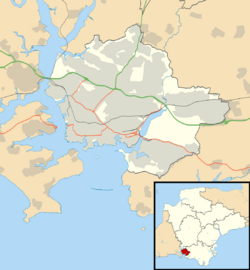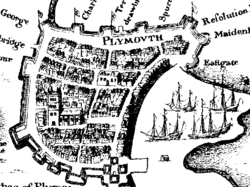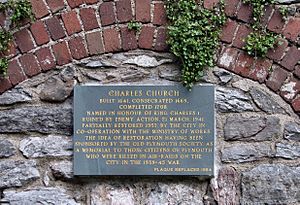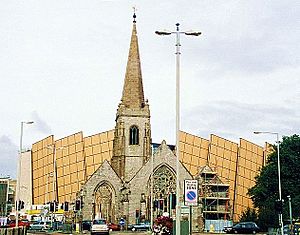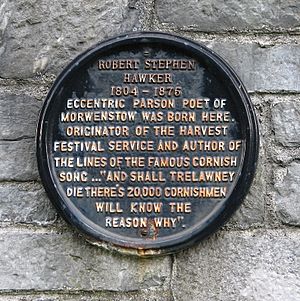Charles Church, Plymouth facts for kids
Quick facts for kids Charles Church, Plymouth |
|
|---|---|
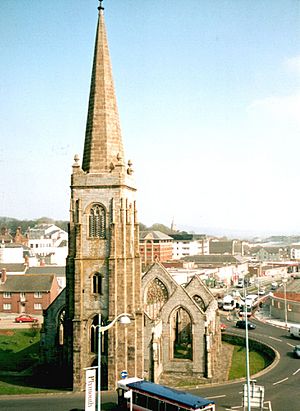
Charles Church, May 2002
|
|
| 50°22′18″N 4°08′09″W / 50.3717°N 4.1358°W | |
| Location | Plymouth, Devon |
| Country | England |
| Denomination | Church of England |
| History | |
| Founded | c. 1640 |
| Dedication | Charles I of England |
| Architecture | |
| Functional status | derelict |
| Heritage designation | Grade I listed |
| Designated | 25 January 1954 |
| Style | Gothic Survival |
| Administration | |
| Diocese | Diocese of Exeter |
Charles Church is a historic church in Plymouth, England, that was badly damaged during World War II. It was once the second oldest parish church in Plymouth, Devon, and is now a special memorial.
Contents
A Look at Charles Church
Charles Church was started around 1640, but it took many years to finish. It was built in a style called Gothic, which means it had pointed arches and tall windows. The church had a tall tower with a spire, a main hall (nave), and side sections (aisles).
The tower was completed in 1708. Its first spire was made of wood and covered in lead. This was later replaced with a stone spire in 1766.
During World War II, on the nights of March 21 and 22, 1941, the church was completely burned by incendiary bombs during the Plymouth Blitz. After the war, people decided not to rebuild it. Instead, in 1958, it was dedicated as a memorial to the 1,200 people who died in the air raids.
Why Charles Church Was Important
For 300 years, Charles Church was a very important place for the people of Plymouth. It was like a "mother church" because it helped start many other churches in the area. Many important religious leaders worked there.
Even though the building is now a ruin, its history of helping the community continues. The church is still a key landmark in Plymouth. Today, St Andrew's Church is considered the main church of Plymouth.
History of Charles Church
Starting the Church (1634-1641)
In 1634, the leaders of Plymouth decided they needed a second church. They asked King Charles I for permission to split the old parish of Plymouth into two.
The main church, St Andrew, was big enough for 1,200 people, and Plymouth had about 8,000 residents. However, there were disagreements about how religion should be practiced. People in Plymouth had different ideas about religion than the King.
Because of these differences, King Charles waited seven years to respond to their request. Finally, Robert Trelawny, a local Member of Parliament, convinced the King to agree. The official papers were signed in 1641, and a law was passed to allow the new church. It cost the town £150.
The old parish was divided, and the new one was to the east. The King insisted the new church be named after him. So, St Andrew's became "the Old church," and Charles Church became "the New church."
The first plot of land for the church wasn't suitable. A second plot of about 1 acre (4,000 square meters) was given by William Warren. This new spot was good for the people in the parish and was near the ruins of an old monastery.
Building the Church (1641-1904)
Building started right away in 1641. But work stopped the next year because of the English Civil War. Men were needed to defend Plymouth, which supported Oliver Cromwell and his Parliamentarian forces against the King.
There are signs that the unfinished church was used to stable horses during the war. However, some parts were used for worship. Weddings, baptisms, and burials were recorded there even before it was fully built. The oldest communion plate dates from 1646.
After the war, building slowly started again because money was tight. The church was mostly finished by 1657. A spire wasn't added until 1708; before that, the tower had a wooden cap. Once completed, the church was a great example of a Gothic-style church built after the English Reformation.
The church was officially dedicated on September 2, 1665. There was a small argument because the bishop wanted to dedicate it to "Charles, King and Martyr." But the people insisted it be named simply "Charles Church," as the King had originally intended.
Towards the end of the 1700s, Dr. Robert Hawker became the minister. He was a very popular speaker, and many people came to hear him. The church grew, and new seating areas (galleries) were added in 1815. The first "daughter church," Charles Chapel, was also built around this time.
The church's wooden spire was blown off in strong winds and replaced by a stone spire in 1766. People even joked that witches had knocked the wooden spire off with their broomsticks!
In 1709, six bells were added to the church. A clock that chimed was given in 1719.
The church also had porches added in 1864. The south porch had a 17th-century pointed doorway, which you can still see in the ruins today.
Church Growth and Changes (1829-1910)
The Victorian era was a time when many churches were built. Plymouth's population grew a lot, and people started moving from the city center to new neighborhoods. This meant more churches were needed to serve the growing number of people.
Charles Church helped start eight "daughter churches" between 1829 and 1910. The first one, Charles Chapel (later renamed St Luke's), was built in 1827. This happened after a disagreement about who should be the new minister after Dr. Hawker passed away.
The church was very active during this time, and many changes and improvements were made to the building.
| 1 July 1829 | St Luke's (Charles Chapel) |
| 21 June 1855 | St John Sutton-on-Plym |
| 19 September 1870 | Emmanuel |
| 27 November 1876 | St Jude |
| 25 October 1887 | St Matthias (now Charles with St Matthias) |
| 15 October 1904 | St Augustine |
| 26 September 1907 | St Simon |
| 26 July 1910 | St Gabriel |
Helping Others and Education
In 1661, Charles Church collected money to help print the Bible in Lithuanian.
The church also supported missionaries. In 1896, the "Charles Own Missionary" Fund began. The first missionary, Miss Emily Bazerley, went to India. In 1901, Miss Ada Pitts sailed for China.
Education was very important to the ministers at Charles Church. The "Household of Faith" Sunday school started in May 1784 with twenty children. This was the first school of its kind in Plymouth. In 1798, the first building made specifically for a Sunday school was opened. It might have been the first purpose-built Sunday school building in the world!
The Charles National school was built in 1837.
Important Ministers
Charles Church had over 25 ministers. Here are a few notable ones:
- Francis Porter (1643-1675): He was the very first preacher at Charles Church.
- Thomas Martin (1690-1711): He helped finish the church tower and raise the spire.
- Walter Hewgoe (1711-1712): His appointment caused some debate, and he eventually resigned.
- Robert Hawker (1784-1827): He was the most famous minister of Charles Church. People called him the "Star of the West" because he was an amazing speaker. He cared deeply for the poor and needy and wrote many books. He was a minister for 43 years.
- James Carne (1827-1832): He made many repairs to the church. He and his wife sadly died while helping families during a cholera outbreak in 1832.
- Septimus Courtney (1832-1843): He was expected to be the next minister after Hawker. Instead, the nearby Charles Chapel (later St Luke's) was built for him.
- Henry Addington Greaves (1846-1878): He oversaw repairs to the spire and tower. He also helped create three daughter churches: St John's, Emmanuel, and St Jude's.
Destruction and Recent History (1941-2002)
After the Battle of Britain in World War II, air raids on Plymouth became very intense. On the night of March 20–21, 1941, Charles Church was destroyed by fire. The people who attended Charles Church then joined other nearby churches.
When WWII ended, it was decided not to rebuild Charles Church. Plymouth had grown, and most people lived in new areas outside the city center. So, it was decided to keep Charles Church as a special memorial to the 1,200 civilians who died in the air raids. In 1958, a service was held to dedicate the church as a memorial.
The church is sometimes used for special services, like remembrance events or carol concerts. In 2001, a special service of reconciliation between Germany and Plymouth was held there.
The church's parish changed names over the years. In 1954, it became "Charles with St Luke." Later, in 1962, it united with St Matthias, becoming "the Church of Charles with St Matthias."
One person who attended the church, Miss Leigh, had mixed feelings about it remaining a memorial. She remembered its beauty and was sad to see it ruined. She said, "To me the church was particularly wonderful because there I got to know God… When it was blitzed in 1941 it was one of the few things that made me cry. My life seemed to be completely broken on that day."
In the mid-1990s, there was a plan to partly restore the church. The idea was to add a modern glass roof and create a museum about the Blitz inside.
Markings and Inscriptions
After the church was destroyed, a man named Mr. G. W. Copeland visited and wrote down many of the historical inscriptions he found. He shared his findings in 1949.
The west tower of Charles Church is built from limestone and granite. It has two date stones: 1657 on the north side and 1708 on the south side.
The East Window of the church was very detailed. There was once a doorway underneath it, which had been walled up in 1665. Its location became clear after the damage from the bombing.
Here are some of the inscriptions found on the bells and other parts of the church after the bombing:
On the Bells
A card in the church recorded the following about the bells:
| Bell | Inscription | Weight |
|---|---|---|
| Tenor | C & G Mears of London Founders 1856. Revd Henry Addington Greaves, Vicar. John Edwards Blewett, William Davey, Churchwardens |
23cwt, 3qrs, 12lb |
| 7th | Similar inscription | 15cwt, 2qrs, 27lb |
| 6th | C Mears of London fecit | approx 12cwt, 2qrs, 27lb |
| 5th | Wm Chapman of London fecit 1782 | 11cwt, 2qrs, 27lb |
| 4th | In wedlocks bands to join with hands your hearts unite, so shall our tuneful tongues combine to laud the nuptial rite |
9cwt |
| 3rd | Such wondrous power to music given. It elevates the soul to heaven | 8cwt |
| 2nd | If you have a judicious ear you'll own my voice is sweet and clear | 7cwt |
| Treble | Same as the Tenor | 6cwt, 1qrs, 23lb |
When the bells fell and broke during the bombing, these inscriptions were seen:
| Bell | Inscription |
|---|---|
| Tenor | RECAST BY GILLETT & JOHNSTONE, CROYDON, 1936.
CHAPMAN OF LONDON FECIT LONDON 1856 (the rest was unreadable) GREAVES VICAR CHURCHWARDENS C & G MEARS FOUNDERS LONDON 1856 REVD HY ADDINGTON GREAVES VICAR (with design) JNO EDWARDS BLEWETT, WM DAVEY – CHURCHWARDENS |
| 5th | WM CHAPMAN OF LONDON FECIT 1782 |
| A broken fragment | IF YOUTH ELEVATES THE SOUL __OWN MY VOICE SWEET AND CLEAR (with design) |
On Other Monuments
Many monuments in the ruins of Charles Church were too damaged to identify. The ones that remained included this plaque.
Images for kids


